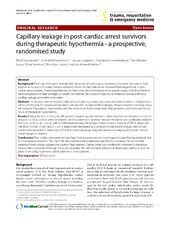Capillary leakage in post-cardiac arrest survivors during therapeutic hypothermia - a prospective, randomised study
Heradstveit, Bård E.; Guttormsen, Anne Berit; Langørgen, Jørund; Hammersborg, Stig-Morten; Wentzel-Larsen, Tore; Fanebust, Rune; Larsson, Elna-Marie; Heltne, Jon-Kenneth
Peer reviewed, Journal article
Published version

Date
2010-05-25Metadata
Show full item recordCollections
Original version
https://doi.org/10.1186/1757-7241-18-29Abstract
Background: Fluids are often given liberally after the return of spontaneous circulation. However, the optimal fluid regimen in survivors of cardiac arrest is unknown. Recent studies indicate an increased fluid requirement in post-cardiac arrest patients. During hypothermia, animal studies report extravasation in several organs, including the brain. We investigated two fluid strategies to determine whether the choice of fluid would influence fluid requirements, capillary leakage and oedema formation. Methods: 19 survivors with witnessed cardiac arrest of primary cardiac origin were allocated to either 7.2% hypertonic saline with 6% poly (O-2-hydroxyethyl) starch solution (HH) or standard fluid therapy (Ringer's Acetate and saline 9 mg/ml) (control). The patients were treated with the randomised fluid immediately after admission and continued for 24 hours of therapeutic hypothermia. Results: During the first 24 hours, the HH patients required significantly less i.v. fluid than the control patients (4750 ml versus 8010 ml, p = 0.019) with comparable use of vasopressors. Systemic vascular resistance was significantly reduced from 0 to 24 hours (p = 0.014), with no difference between the groups. Colloid osmotic pressure (COP) in serum and interstitial fluid (p < 0.001 and p = 0.014 respectively) decreased as a function of time in both groups, with a more pronounced reduction in interstitial COP in the crystalloid group. Magnetic resonance imaging of the brain did not reveal vasogenic oedema. Conclusions: Post-cardiac arrest patients have high fluid requirements during therapeutic hypothermia, probably due to increased extravasation. The use of HH reduced the fluid requirement significantly. However, the lack of brain oedema in both groups suggests no superior fluid regimen. Cardiac index was significantly improved in the group treated with crystalloids. Although we do not associate HH with the renal failures that developed, caution should be taken when using hypertonic starch solutions in these patients.
Publisher
BioMed CentralJournal
Scandinavian Journal of Trauma, Resuscitation and Emergency MedicineCopyright
Copyright 2010 Heradstveit et al; licensee BioMed Central Ltd.Heradstveit et al.
